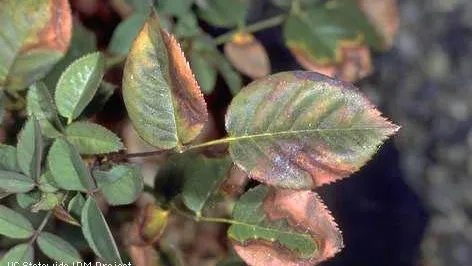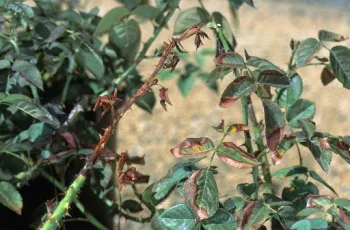Drought Effects on Plants
How long-term water deficits stress plants

Water is essential for the chemical and physical processes that plants need to survive and grow. Healthy plants depend on the movement of water from the soil through the roots and up into the leaves.
Water evaporates from plant leaves through tiny pores that open and close in response to water availability. When the flow of water through the plant is reduced, leaves begin to wilt.
Drought is a prolonged shortage in water supply due to below normal precipitation. It doesn’t have a clear beginning and end like other gardening extremes. Lack of rain and snow over time ultimately results in a lack of soil moisture available to plants. During drought, water restrictions may be necessary as the ground water table is reduced and reservoir levels decline.
Drought has both short term and long term effects on plants:
• Damage is first apparent in the wilting, yellowing, and dropping of leaves. Leaves may curl and look scorched.
• Eventually plants will begin to show signs of decline as tips of branches become dry and brown.
• New growth will be stunted.
• When damage is severe, no amount of watering can undo it.
Drought stress weakens plants - Prolonged water deficit lessens a plant’s natural defenses. Drought related stress increases susceptibility to disease infections and insect invasions.
What can be done to keep plants alive during drought?

Check plants frequently for signs of drought. Plants need to be watered before irreversible damage occurs. Early morning is the best time to water as the rate of evaporation from soil is lower then.
Rule out other causes of plant stress. On hot days plants may not be able to absorb water quickly enough to compensate for water lost through their leaves and temporary wilting will occur. In this case the signs of drought are temporary and plants will recover on their own during the evening.
Apply and maintain a layer of mulch three to four inches deep around garden plants and trees (except one foot away from tree trunks) to retain soil moisture and discourage weeds.
Avoid over fertilizing when water is scarce. Supplemental fertilization increases leaf production and the need for more water. Most mature landscape plants can survive a season or two without additional fertilization.
Control weeds. Weeds can outcompete garden plants for water. Pull them when they are small, making sure to remove all the roots.
Prioritize your landscape plant needs during a water shortage. Mature trees and shrubs can usually be kept alive with occasional deep watering during exceptionally dry seasons. Although fruit and nut trees can be kept alive during severe water shortages for a season or two, fruit production may be greatly reduced.
Decrease vegetable garden size and plant only favorites when water is limited. Vegetables are not drought resistant plants and are difficult to maintain without sufficient water. Compost and mulch are both important in retaining soil moisture in vegetable gardens and can stretch the time a plant can go between waterings.
Reduce water waste in lawns by correcting sprinkler problems and adjusting application rates based on seasonal demands. On average, 20 to 40 percent of water applied to lawns and groundcovers is wasted through over application and faulty irrigation systems. During a water shortage, it is possible to keep a lawn alive by gradually reducing water to one-half the recommended amount.
Increase the mowing height for lawn grass and cut fertilization rates to one-half or less of recommended rates. Reducing water needs also helps lawns survive.
Consider replacing thirsty plants with drought-resistant species and plants that can stand summer heat but wait until fall or spring when the water needs for newly established plants are not as high.
> BACK TO PROBLEMS
> Dealing With Extreme Conditions:
> Heat
> Frost
> Flood
> Wind
RELATED:
> Plants That Can Take Summer Heat
> Succulents & Extra Low-Water Plants
STRATEGIES FOR DROUGHT GARDENING

